Most Europeans learn nothing about the history of Persia between the Battle of Salamis (480 BC) and the overthrow
of its democracy (1953 AD), so here's a very brief summary to give some context.
It slides over a lot of details and ignores the fact that "Persia" was usually not coextensive with present-day Iran,
and was sometimes split between different empires.
The gaps are mostly transition periods when different groups were vying for control.
| Achaemenian Dynasty (Cyrus, Darius, Xerxes ...) | 559-330 BC |
| Alexander the Great conquers Persia | 330 BC |
| Persia mostly part of Seleucid empire (Seleucus was one of Alexander's officers) | 312-250 BC |
| Parthian dynasty | 247 BC - 224 AD |
| Sassanid dynasty | 225-636 AD |
| The Arab conquest | 630-650 |
| Abbasid dynasty | 750-873 |
| Seljuq Dynasty | 1045-1221 |
| Genghis Khan's army invades | 1221 |
| It took 700 years for Persia's population to recover to what
it had been at the time of Genghis Khan's invasion. |
| Part of Mongol Empire | 1256-1384 |
| Tamerlane invades | 1384 |
| Timurid Dynasty | 1405-1502 |
| Safavid Dynasty | 1502-1737 |
| Qajar Dynasty | 1795-1925 |
| Pahlavi Dynasty, developing into a democratic constitutional monarchy | 1925-1953 |
| Puppet government under varying degrees of US control | 1953-1979 |
| Islamic revolution | 1979 |
Because of the tumultuous history, during which several waves of invaders destroyed whatever buildings they encountered,
few monuments from Persia's ancient past remain. The main exceptions are Persepolis and the Achaemenian tombs.
Click on the little images to enlarge them.
| Started by Cyrus, mostly completed by Darius in about 500 BC, but added to by later Achaemenian rulers,
Persepolis was destroyed by Alexander.
Most of its pillars were made of wood (cedars from Lebanon and teak from India),
so when Alexander burned it down, little of the overall structure remained.
That is why Persepolis is less impressive in a overall view than some other ancient buildings. |
 |
| The Gate of Nations. The retaining wall and dual stairways have survived more or less intact.
(The main part of the site is off to the right.) |
 |
 |
| In contrast, many of the details of the stone carving are well preserved; the site
is in an arid area, and its location was not widely known to Europeans until the seventeenth century. |
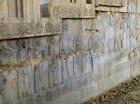 |
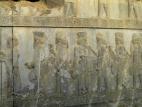 |
 |
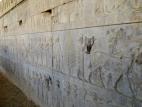 |
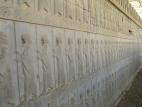 |
| The inscriptions at Persepolis are almost all in cuneiform, though not all of them are in Old Persian
(the language of the Achaemenians). Cuneiform, during its long history, was adapted to several different languages.
This inscription is in Old Persian, easily identifiable by its use of a single slanting stroke as a separator. |
 |
 |
| About 12km to the north-west of Persepolis are the tombs of four Achaemenian rulers. The third
from the left (middle picture here) is that of Darius I, the others are not conclusively identified. The tombs were looted during
Alexander's invasion. |
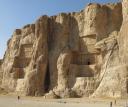 |
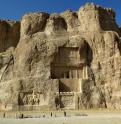 |
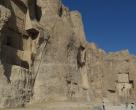 |
| Near these four tombs is this building. It is largely solid, though there is a small room
at the top, and its purpose is not known with certainty. It is thought to be a Zoroastrian building. |
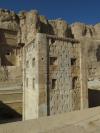 |
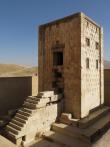 |
| Cyrus the Great's tomb is at Pasargadae, about 35km from Persepolis
(the distance by road is much greater because the road runs through part of the Zagros mountains).
It is now empty, but otherwise largely intact. |
 |
| |















